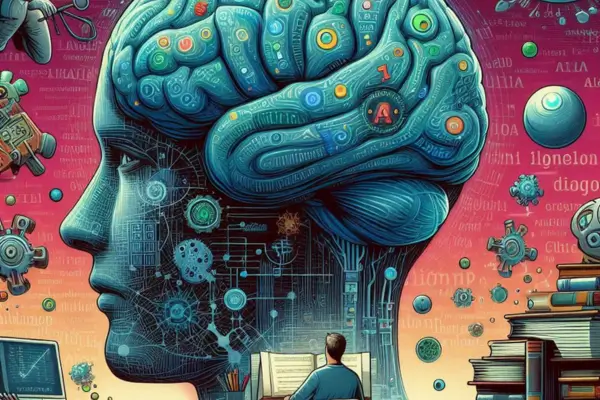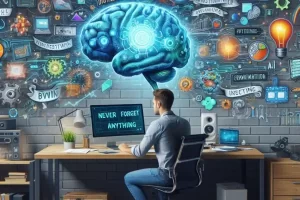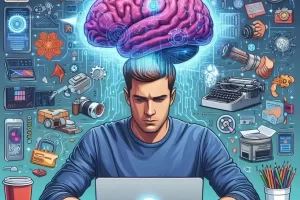Your personal development journey is filled with insights, reflections, habits, goals, and lessons. But without a place to store, organize, and revisit all of that, growth becomes inconsistent — and easily forgotten. That’s why building a second brain for personal development, powered by artificial intelligence (AI), is a transformative move for anyone committed to becoming their best self.
In this article, you’ll learn how to design a second brain specifically focused on self-growth, and how AI can help you track your evolution, reflect with clarity, and accelerate your transformation.
Why You Need a Personal Development Second Brain
Personal development is not a one-time event — it’s a lifelong system of:
- Learning new concepts
- Building better habits
- Gaining self-awareness
- Reflecting on your behavior
- Setting and adjusting goals
- Tracking progress over time
Without a system, much of this gets lost in scattered journals, books, or apps. With a second brain and AI:
- You centralize your self-growth journey
- You can measure change over time
- You stay focused on what’s working
- You develop a deeper relationship with your thoughts and behaviors
Define the Core Pillars of Your Personal Growth
Start by identifying the key areas you want to grow in. These will guide how you organize your second brain.
Examples:
- 🧠 Mindset
- 🧘 Emotional intelligence
- 🏃 Health and energy
- 📚 Learning and skills
- 💬 Relationships
- 💼 Career growth
- 🎯 Purpose and meaning
Use AI to help:
“Based on my journal and goals, what areas of personal development am I focused on most?”
“Suggest 6 categories to organize my personal development notes and reflections.”
Create a Personal Growth Hub
In your second brain platform (like Notion, Obsidian, or Tana), create a central dashboard for your personal development.
Include sections like:
- Long-term personal goals
- Weekly and monthly reflections
- Habit tracking
- Journaling
- Book and course notes
- Identity shifts and mindset breakthroughs
Use AI to:
“Summarize my reflections this month into a personal growth report.”
“Generate a dashboard view of my top 3 goals and progress.”
“What new habits should I consider based on my recent challenges?”
Capture Insights from Books, Courses, and Experiences
Every time you learn something new — whether from a book, podcast, mentor, or situation — it’s an opportunity to grow.
Your second brain should help you:
- Save and summarize those insights
- Link them to relevant themes
- Turn them into actionable principles
AI can help by:
- Summarizing highlights
- Extracting key lessons
- Suggesting related ideas from your past notes
Prompt examples:
“Summarize the 5 key lessons from these book notes.”
“What other ideas in my second brain connect to this insight on discipline?”
Build a Habit and Behavior Tracker
Self-growth isn’t just about learning — it’s about doing.
Set up a habit tracker with AI-enhanced feedback. Track:
- Morning routines
- Focus and productivity
- Physical health (sleep, exercise, diet)
- Emotional responses
- New challenges or changes
Ask AI:
“How consistent have I been with my daily habits this month?”
“What’s the relationship between my mood and my morning routine?”
“Which habits support my energy the most, based on the data?”
This lets your second brain become your behavioral feedback system.
Use AI for Deep Reflection
AI can enhance your journaling and reflection by helping you ask better questions and recognize deeper patterns.
Try prompts like:
“Summarize my emotional themes from the past week.”
“What limiting beliefs show up often in my journals?”
“What lessons do I keep relearning?”
You can even say:
“Write a reflective entry for me based on this week’s journal and wins.”
Now journaling becomes an interactive, insightful dialogue — not just a monologue.
Track Identity and Mindset Shifts Over Time
Personal development is as much about who you become as it is about what you achieve.
Create a space to track:
- Identity shifts
- New beliefs adopted
- Mindset changes
- Internal narratives transformed
Ask AI:
“What statements in my journal reflect a growth mindset?”
“What limiting beliefs have I let go of this year?”
“How has my language changed around productivity and self-worth?”
These patterns help you witness your evolution clearly.
Create a Personal Growth Review System
Each week or month, use AI to guide you through a personal growth review. Include:
- Wins and challenges
- Emotional trends
- Progress toward goals
- Lessons learned
- Adjustments needed
Prompts to automate your review:
“Summarize my personal development entries for this week.”
“What did I learn about myself this month?”
“What personal goal should I focus on next month?”
This turns self-growth into a deliberate, trackable practice.
Real-Life Example: The Growth-Focused Professional
Let’s say you’re focused on emotional resilience, leadership, and health.
Your second brain includes:
- Reflections on daily challenges and wins
- Quotes and insights from emotional intelligence books
- A habit tracker for sleep, journaling, and screen time
- Weekly AI-generated summaries that show which habits improved mood
- Monthly reports on mindset patterns and identity shifts
You’re not just growing — you’re witnessing and directing your growth.
Final Thoughts: Grow With Intention, Powered by AI
Most people leave their personal development to chance. But when you build a second brain — and use AI to support it — you create a framework for consistent, intentional transformation.
You don’t have to remember every lesson.
You don’t have to track every emotion manually.
You don’t have to figure it all out alone.
Your second brain becomes your coach, mirror, and guide — always ready to help you understand yourself, challenge your assumptions, and stay aligned with your highest self.
Start capturing. Start reflecting. Let AI reveal your patterns — and help you evolve.




